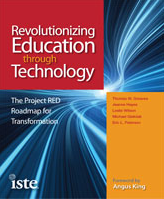Education Success Measures
Education Success Measures
The success or failure of a school program can be determined in numerous ways. As any educator will tell you, test scores are important, but they are only one measure of success. The Project RED team analyzed over 4,000 pages of reports and evaluations from technology-rich implementations, primarily from 1:1 programs, and found little commonality in the success factors measured by schools.
Lacking a national consensus, we chose 11 education success measures that provide a balanced view. Many appear frequently in the research literature, and a few are new to this study (primarily those related to financial impact, which is rare in the literature).
These 11 ESMs were selected in order to elicit the most valuable information for our hypotheses with the fewest number of variables. The measures were divided into two groups, those that affect students in all grades and those that affect students in high schools.
All Schools
- Disciplinary action rate. The frequency of disciplinary actions is a strong, leading indicator of academic success or failure. Fewer disciplinary actions mean that students are more likely to be engaged in learning. Also, every disciplinary action costs time and money.
- Dropout rate. Dropouts are an extreme indicator of the lack of academic success and lead to high personal and societal costs.
- High-stakes test scores. Any school improvement program needs to have a focus in this area.
- Paper and copying expenses. This factor is a proxy for other similar school expense centers. Paper and copying machine expenses are more significant than often realized, particularly when labor is included.
- Paperwork reduction. This factor is a proxy for efficiency savings attributable to technology. When paperwork is reduced, teachers have more time to spend on educationally productive tasks, and schools save other costs (such as storage and records retention).
- Teacher attendance. Substitute teachers cost the district money and may impact student performance.
High Schools
- AP course enrollment. This factor indicates the quality of curriculum and instruction and reduces the time required to graduate from college, saving money for the state and for families.
- College attendance plans. This factor indicates the quality of curriculum and instruction and facilitates students’ educational planning.
- Course completion rates. This factor indicates student engagement, achievement, and school quality. Conversely, course failure has severe negative academic and financial implications.
- Dual/joint enrollment in college. This factor indicates a high level of student achievement and savings in future college expenses. The state saves money in subsidies for higher education and starts receiving tax revenues earlier.
- Graduation rates. This factor indicates school quality and effective curriculum, instruction, and student planning. Multiple indicators, such as graduation and course completion rates, allow for better triangulation on a self-reported survey.
Independent Variables of Survey
The Project RED Survey consisted of questions regarding 22 independent variables, some with subcategories, chosen for their potential to provide insight into the education success measures (ESMs). As with the education success measures, many variables could not be included due to the limitations of survey size and the effects of survey fatigue.
The number of subcategories in each variable is noted in parentheses. Project RED was designed to provide data for later analysis of the relationships between the 22 independent variables and the 11 education success measures.
- Types of devices (6)
- School usage patterns (7)
- Levels of use by subject (14 subjects, 6 levels of use)
- Primary impetus of the program (11)
- Sources of funding (9)
- Parental involvement—measured by face-to-face meetings or trainings (1)
- Teachers—when issued devices, relative to students (1)
- Technology plan quality (6)
- Program sustainability (1)
- Pedagogical models (4) and usage patterns (6)
- Classification of types of classroom use (12) and frequency (7)
- Principal training—types (6) and frequency (5)
- Principal’s leadership role (5) and frequency (5)
- Teacher professional learning—categories (8) and frequency (5)
- Professional learning budget (3)
- Technology systems reliability (5)
- Network accessibility (3)
- Internet connection speed (5)
- Student-computer ratio (5)
- Grades covered (1)
- Year of implementation and length of implementation (1)
- Type of institution (1)
 |
||
| To order our full research report, click on the image. | ||
 |
||
|
To view the new Project RED ISTE book, click on the image.
To download a free e-version of Revolutionizing Education through Technology, click here. |
||